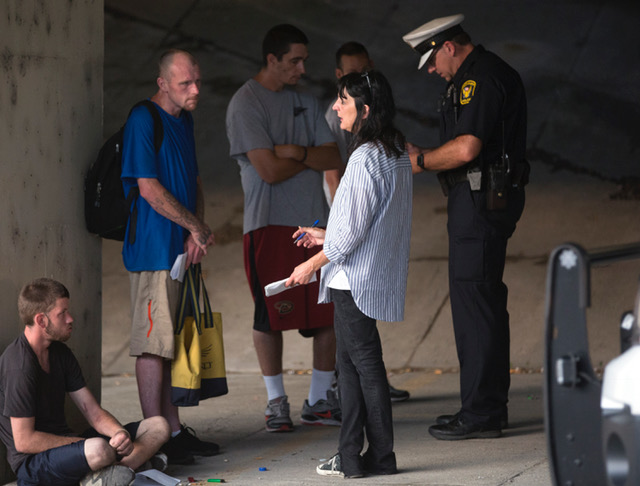THE HEROIN EPIDEMIC HAS BEEN my full-time beat at The Cincinnati Enquirer for two years, but I’ve covered it for five. I read comments regularly from parents who belong to Kentucky Parents Against Heroin, a private Facebook page for help and support, and talk to those same parents. Their kids are sick, dying, and can’t get treatment quickly enough, if at all. Those who get treatment aren’t likely to get the best kind.
Paramedics and police are exhausted from responding to overdoses, and they’re suffering from compassion fatigue. Hospital neonatal intensive care units are filling with babies born with neonatal abstinence syndrome, and social workers are removing children day after day from heroin-addicted parents. Courts, jails, the methadone clinic, and rehab centers are filled with the addicted. It seems as though everyone I talk to has a connection to the epidemic.
As a story, “Seven Days of Heroin”—the Enquirer’s September 10 feature, a week in the life of my region’s opioid crisis as documented by more than 60 journalists—was there all along. We just had to do it. So we picked a week.
ICYMI: “Journalistic carelessness caused the project to backfire, and thus miss its target”
I called dozens of sources and laid out the idea. Former Enquirer editor Peter Bhatia (who is headed to the Detroit Free Press) supported our idea full-on, and put Amy Wilson, our storytelling editor, at the helm. Dan Horn, an outstanding writer on our team, had talked with me years earlier about the idea of covering the epidemic over a period of days, and jumped right in. Ultimately, every editor, photographer, and reporter did the same.
Enquirer journalists and several others from Gannett’s Media Network of Central Ohio had seen this epidemic on their own beats—nearly every one of them. They pitched ideas and reached out to their own sources. And then, from July 10 through July 16, all of us (including our seven summer interns) hit the streets.
I’d been in touch with many people in recovery over the years, and so we trusted each other. I went to the streets with Liz Dufour, one of the photographers who’d covered this epidemic with me. We hung out with people who had lost families, finances, and homes during their addictions.

Terry DeMio talks to Justin, a heroin-addicted homeless man in Cincinnati. DeMio tells CJR that Justin said, “I don’t want this,” but noted that treatment is difficult to get on demand. He doesn’t have a phone, and he can’t call treatment centers every day, which is the protocol to get in. Photo by Liz Dufour/Enquirer.
We waited for a death, which came soon: a 34-year-old man named Tommy Burke. I knew his family’s closest friend, and reached out to her. She helped us tell the story of Tommy and his family and friends, which runs through our larger “Seven Days” story.
RELATED: Photos reveal media’s softer tone on opioid crisis
I warned my colleagues that someone they spoke to could die. We would have to check in on those with addiction whom we wrote about. Ten days after reporters left a happy visit with a mother named Stephanie Gaffney and her baby, Elliana, we got a call: Gaffney had died from an overdose.
I watched Facebook. Reporters monitored 911 radio traffic. We rode with paramedics and police. Data reporter Carrie Blackmore Smith worked with a team to track overdose numbers, deaths, and various costs to taxpayers. That sounds simple, but it required the advanced knowledge of what data we needed, along with the cooperation and assistance of about 45 agencies. We got it.
In the middle of our reporting, a Hamilton County coroner’s assistant wrote in an email that this was an unusually slow week for overdoses. That was fine. We wanted a normal week. It was terrible enough.
Reporters gave their notes to Dan Horn and me, sometimes presented in vignettes. We created a storyboard, and painstakingly eliminated what couldn’t fit or didn’t work just right—episodes that included rallies for recovery and drug court victories. A judge for the Warren County Drug Court, which oversees a recovery program for those with addiction who are convicted of nonviolent felonies, told participants in a program that one of their graduates had died from an overdose—another scene from a “normal” week that didn’t make our story.
We wrote tight scenes with the rest of the notes, and worked with photojournalists on words for our 31-minute documentary video. Carrie Cochran, our Emmy Award-winning visual journalist, assembled and produced the video with help from more colleagues.
The decision to tell the story chronologically wasn’t really a decision; it had to be told this way. A chronology of one week to show what a heroin epidemic looks like every week.
CJR’s health care reporting is sponsored in part by a grant from the Commonwealth Fund.
RELATED: Four facts every journalist should know when covering the opioid epidemic
Terry DeMio is the heroin reporter for The Cincinnati Enquirer, where she has covered the heroin epidemic as a full-time beat for two years. A journalist for 25 years, DeMio lives in Northern Kentucky.

